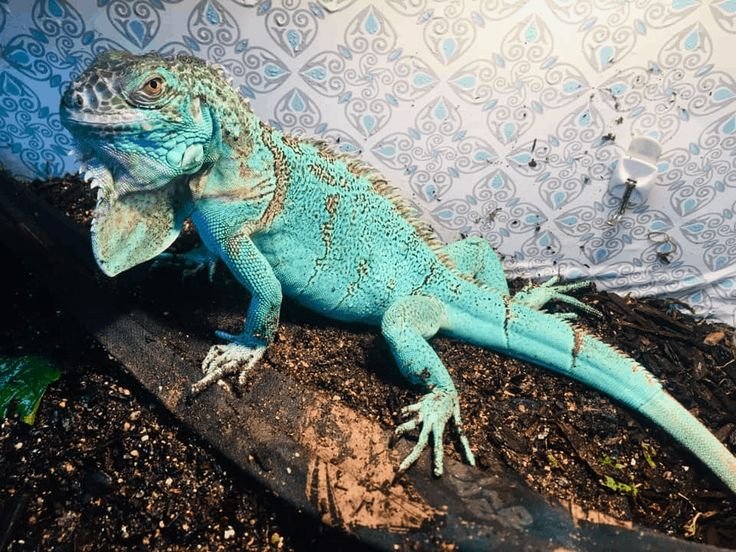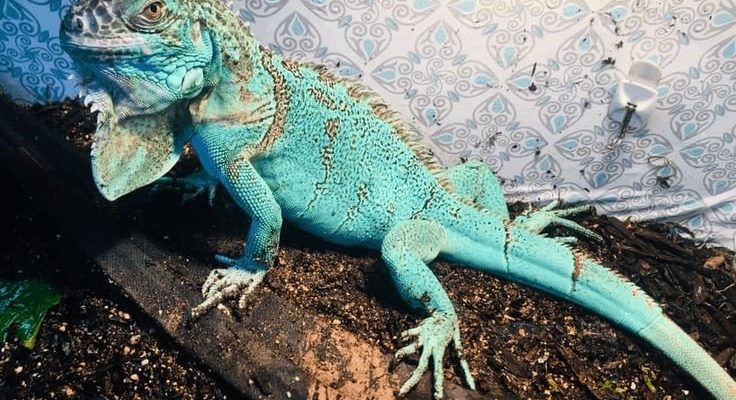
Blue iguanas, native to the Grand Cayman Islands, can reach quite a size. They can grow up to an amazing 5 feet long, including their tail, and weigh anywhere from 10 to 30 pounds. So, if you’re thinking of bringing one home, let me explain what that means for their enclosure and care. The right size habitat is essential to keep these beauties happy and healthy, and it’s not just about length—height and width matter too!
Understanding the Size of Blue Iguanas
When we talk about size, it’s important to break it down into two main parts: length and weight. The average blue iguana can reach a length of 4 to 5 feet from nose to tail tip. This might sound pretty big, but remember, this is a creature built for climbing and basking. They need space to stretch out and showcase their natural behaviors.
In terms of weight, these iguanas typically fall between 10 to 30 pounds. Male blue iguanas generally weigh more than females, often due to their larger size and muscle mass. If you’re picturing this as a pet, think about whether you’re ready for a lizard that could weigh as much as a small dog. Honestly, this size means they need both physical space and mental stimulation to stay healthy and active.
Importance of Size in Their Habitat
Now, you might be wondering why their size matters so much. Well, the larger the iguana, the more space they need. A cramped environment can lead to stress and health issues. Imagine living in a tiny room with no way to stretch your legs! Blue iguanas need room to roam, climb, and bask—everything that makes them tick.
A good rule of thumb is to provide a habitat that is at least 6 feet long, 3 feet wide, and 3 feet high for an adult blue iguana. This allows them to move freely and feel secure in their space. If you can provide more room, that’s even better! Larger enclosures can help prevent behavioral issues and encourage natural behaviors, making for a happier lizard.
Enclosure Requirements for Blue Iguanas
If you’re ready to build or buy an enclosure for a blue iguana, think about the materials you’ll use. A sturdy cage made of wood, glass, or metal works best. Avoid plastic, as it can trap heat and moisture, leading to unhealthy conditions. You want something that can handle their size and activity level without warping or breaking.
When setting up their home, keep in mind that blue iguanas are climbers. They love to perch on branches or large rocks, so adding shelves or climbing structures inside their enclosure is essential. You can use untreated wood branches for perches or create a multi-level setup with ramps. Just ensure everything is secure and can support their weight!
Temperature and Humidity Considerations
Temperature is a crucial factor in creating a comfortable environment for your blue iguana. They thrive in warmer climates, so you should aim for a basking spot of around 95°F (35°C) and a cooler area of about 70°F (21°C). A good quality basking lamp can help achieve this. You might also want to have a thermometer handy to keep an eye on the temperature throughout the day.
Humidity is equally important. Blue iguanas prefer humid environments of around 60-70% relative humidity. You can achieve this by using a misting system or a humidity gauge. Regular misting can also help encourage healthy shedding, keeping their skin looking vibrant and fresh.
Feeding Requirements for Blue Iguanas
All that space and warmth isn’t just for show—blue iguanas need a balanced diet to maintain their health and size. They are mainly herbivores, so a good diet includes leafy greens, fruits, and vegetables. Fresh greens like collard greens, dandelion greens, and mustard greens are top choices.
You might be tempted to add fruits, but moderation is key. High-calcium fruits like papaya and mango can be offered occasionally as treats. Avoid feeding them anything with high oxalate levels, such as spinach, as this can hinder calcium absorption. Even though they look fierce, their diet plays a huge role in their overall well-being and growth.
Common Health Issues Related to Size
When we’re discussing blue iguanas and their impressive growth, it’s essential to be aware of some common health issues they might face. Over time, improper care can lead to conditions like metabolic bone disease or obesity. Keeping an eye on their diet, exercise, and habitat can help prevent these problems.
If your iguana isn’t getting enough calcium, it might experience deformities or lethargy. On the other hand, if it doesn’t have enough space to move, it could lead to obesity, which can strain their organs. Regular vet check-ups are always a good idea if you want to keep your blue iguana healthy and thriving.
Final Thoughts on Caring for a Blue Iguana
Caring for a blue iguana is a big commitment that goes beyond just admiring their beauty. From their impressive size to their unique habitat needs, there’s a lot to consider. As a potential owner, it’s about creating the right atmosphere for them to thrive, ensuring they have enough space to grow, and providing a proper diet.
In the end, these stunning reptiles can be incredibly rewarding companions if their needs are met. If you’re ready to take on the responsibility, you’ll find that the joy of watching a blue iguana flourish in your care is worth the effort. Just remember to do your research, prepare adequately, and enjoy the experience of having this unique creature in your life!

